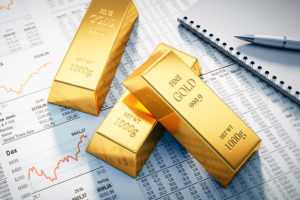Commodity sector supported by peak interest rates and limited supply
The strengthening we forecast that materialized in key raw materials in the third quarter is likely to continue into the last quarter of this year as increasingly poor economic forecasts in Europe and the United States, and to a lesser extent in China, continue to more than offset concerns. about supply. This is primarily visible in the energy sector, where active supply management by the OPEC+ group of producers has proven to be extremely effective, ensuring a very limited, price-friendly level of supply on the crude oil and fuel products market.
Precious metals
Precious metals performed well in the third quarter, and gold prices were almost unchanged despite the appreciation of the dollar, a large increase in US Treasury yields and emerging expectations that FOMC will keep official interest rates higher for longer. However, given the heightened risk that economies on both sides of the Atlantic could head towards stagflation, we see potential for a strong quarter for investment metals such as gold, silver and possibly platinum as well, given its current low price relative to gold .
The timing of a favorable peak interest rate scenario for precious metals remains unclear as central banks continue to fight inflation, made more difficult by the recent energy boom. But, as Althea Spinozzi writes in her bond market forecast, persistent inflation does not necessarily mean more rate increases. The increases in increases have already become smaller, and some central banks have even suspended increases at recent meetings. This means that we are nearing the end of the interest rate hike cycle, or that it may have already ended.
Monetary policy will next be fine-tuned to maintain a hawkish stance as inflation remains above central bank targets. However, there will be dark clouds on the horizon in the form of a slowdown in economic activity and geopolitical risks, which will create conditions for a bull market - not only in the bond market, but also in the precious metals market - as yields stabilize and investors increasingly focus on on the need to reduce real yields, which in the United States, given current forecasts, have reached unsustainably high levels.
We patiently maintain a constructive view on gold, and therefore also on silver and platinum, and predict that the yellow metal will eventually reach a new record in the coming months. However, the timing of the new growth impulse will remain largely dependent on US economic data as we wait for the FOMC to switch from rate increases to rate cuts; until then, just like last quarter, we will likely see further chaotic activity from traders in the market.
Industrial metals
In the industrial metals market, the focus will continue to be on the Chinese government's efforts to stabilize the economy, real estate sector and currency, while demand for so-called green metals will continue to provide a soft bottom for prices as demand for these raw materials continues to grow as global electrification is gaining momentum.
Long-term investors continue to point out the lack of large mining projects to ensure a steady flow of future supplies. This confirms our structurally constructive forecast due to the growing demand for metals related to the green transition - in particular copper - and the fact that mining companies are struggling with rising costs due to increases in input prices due to higher costs of diesel and power. labour, inferior grades of ore, rising regulatory costs and government intervention, as well as significant climate change causing disruptions to production - from floods to droughts. This situation is already visible: stocks of key mined metals monitored by stock exchanges remain at a level close to the multi-year minimum.
We maintain our long-term positive outlook for copper, which is currently in a wide range of $3,25 to $4,25. In the short term, price direction will primarily be influenced by changes in the Chinese yuan exchange rate, before prices eventually rise as forecasts of tight supply and strong electrification-related demand come to the fore, driving prices to new record highs at some point next year.
Crude oil and fuel products
The emerging risk of stagflation, which we believe supports investment metals, has been amplified by the successful attempt by OPEC+ producers to drive up energy prices. Facing too low prices, key producers oil, led by Saudi Arabia, have been limiting supply on the energy market by cutting production since April. However, despite the group's initial assurances that this decision was motivated by the need for a stable and sustainable market, it became increasingly clear to investors that the main goal was to increase prices to optimize revenues.
The recent increase in the price of Brent crude oil towards USD 100 was caused jointly by the announcement of the extension of voluntary production cuts until the end of the year by Russia and Saudi Arabia and the information contained in the monthly report OPECthat in the fourth quarter there may be a shortage of 3,3 million barrels per day on the global oil market. While the IEA predicts a more moderate but still worrying supply deficit, the oil price outlook has become significantly more favorable. The current tight supply is increasingly the result of very low levels of diesel stocks following a reduction in supplies of diesel fuel from Russian and Middle Eastern producers. The risk of higher prices in the fourth quarter cannot be ruled out, and our price forecast should reflect the fact that OPEC+ is focusing more on price optimization than on price stability; it is also impossible to ignore the short-term risk of an increase in the price of Brent crude oil towards USD 100 or even temporarily exceeding this level.
However, while OPEC can control supply and thus increase production reserves - which rarely goes hand in hand with higher prices - its impact on demand is limited, and as inflationary pressures related to higher energy prices and unfavorable economic forecasts re-intensify, concerns about demand will come into focus again. Only at this point will the market begin to look for a bottom that the increasingly assertive OPEC group will try to defend, potentially somewhere around USD 85.
Agricultural products
While world food prices, according to the FAO Global Food Price Index, fell by 12% year-on-year, there was a marked difference in the performance of the agricultural sector in the third quarter, as the cereals and soybean sectors declined while the so-called soft products came second in terms of performance after the energy sector. Corn futures prices i wheat Chicago-listed stocks fell following a crop season in which crops turned out better than initially feared, offsetting lingering concerns about wheat supplies from Ukraine. In the coming months, market attention will focus on weather conditions in the Southern Hemisphere, particularly in Australia, where fears of La Niña-related heat are growing, and in South America, which is increasingly replacing the United States as a key supplier corn i variety to China - the country that is the world's largest importer of these products. Meanwhile, the soft goods sector is and will likely remain supported by heat concerns in Asia, which have already led to a reduction in sugar and rice exports while a sharp decline in orange juice production in Florida.
About the Author
 Ole Hansen, head of department of commodity market strategy, Saxo Bank. Djoined a group Saxo Bank in 2008. Focuses on providing strategies and analyzes of global commodity markets identified by foundations, market sentiment and technical development. Hansen is the author of the weekly update of the situation on the goods market and also provides customers with opinions on trading goods under the #SaxoStrats brand. He regularly cooperates with both television and printed media, including CNBC, Bloomberg, Reuters, Wall Street Journal, Financial Times and Telegraph.
Ole Hansen, head of department of commodity market strategy, Saxo Bank. Djoined a group Saxo Bank in 2008. Focuses on providing strategies and analyzes of global commodity markets identified by foundations, market sentiment and technical development. Hansen is the author of the weekly update of the situation on the goods market and also provides customers with opinions on trading goods under the #SaxoStrats brand. He regularly cooperates with both television and printed media, including CNBC, Bloomberg, Reuters, Wall Street Journal, Financial Times and Telegraph.






















![Forex Club – Tax 9 – Settle tax on a foreign broker [Download the Application] Forex Club - Tax 9](https://forexclub.pl/wp-content/uploads/2024/02/Forex-Club-Podatek-9-184x120.jpg?v=1709046278)
![Trading View platform – solutions tailored to the needs of traders [Review] trading view review](https://forexclub.pl/wp-content/uploads/2024/03/trading-view-recenzja-184x120.jpg?v=1709558918)
![How to connect your FP Markets account to the Trading View platform [Guide] fp markets trading view](https://forexclub.pl/wp-content/uploads/2024/02/fp-markets-trading-view-184x120.jpg?v=1708677291)
![CRB index – one of the popular commodity market benchmarks [Guide] crb index](https://forexclub.pl/wp-content/uploads/2024/05/indeks-crb-184x120.jpg?v=1715055656)
![How to invest in ChatGPT and AI? Stocks and ETFs [Guide] how to invest in chatgpt and artificial intelligence](https://forexclub.pl/wp-content/uploads/2023/02/jak-inwestowac-w-chatgpt-i-sztuczna-inteligencje-184x120.jpg?v=1676364263)





![Izabela Górecka – “Success on the market depends not only on knowledge, but also on emotional stability” [Interview] Izabela Górecka - interview](https://forexclub.pl/wp-content/uploads/2024/04/Izabela-Gorecka-wywiad-184x120.jpg?v=1713870578)
![WeWork – the anatomy of the collapse of a company valued at $47 billion [WeWork, part II] wework bankruptcy story](https://forexclub.pl/wp-content/uploads/2024/04/wework-bankructwo-historia-184x120.jpg?v=1711729561)
![Adam Neumann – the man who screwed up Softbank [WeWork, part AND] adam neumann wework](https://forexclub.pl/wp-content/uploads/2024/04/adam-neumann-wework-184x120.jpg?v=1711728724)


![The most common mistakes of a beginner trader - Mr Yogi [VIDEO] Scalping - The most common mistakes of a beginner trader - VIDEO](https://forexclub.pl/wp-content/uploads/2024/03/Scalping-Najczestsze-bledy-poczatkujacego-tradera-VIDEO-184x120.jpg?v=1711601376)
![Learning patience: No position is also a position - Mr Yogi [VIDEO] Scalping - Learning patience - No position is also a position - VIDEO](https://forexclub.pl/wp-content/uploads/2024/03/Scalping-Nauka-cierpliwosci-Brak-pozycji-to-tez-pozycja-VIDEO-184x120.jpg?v=1710999249)
![When to exit a position and how to minimize losses - Mr Yogi [VIDEO] Scalping - When to exit a position and how to minimize losses - VIDEO](https://forexclub.pl/wp-content/uploads/2024/03/Scalping-Kiedy-wyjsc-z-pozycji-i-jak-minimalizowac-straty-VIDEO-184x120.jpg?v=1710336731)











Leave a Response